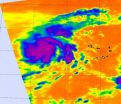(Press-News.org) Washington, DC – In order for targeted therapies against cancer to be effective, scientists need to understand upfront what related proteins in a signaling "network" makes a cancer cell resistant to a drug and selectively target them as well, say researchers at Georgetown Lombardi Comprehensive Cancer Center and Fox Chase Cancer Center.
In the September 21 issue of Science Signaling, the investigators discuss how cancer cells activate a network of pro-growth proteins that can bypass a molecule being therapeutically targeted. The researchers specifically found that many different genes were involved in rescuing cancer cells from treatment by different FDA-approved drugs that are designed to shut down the epidermal growth factor receptor (EGFR) – a major driver of cancer and a target of many new therapies.
This evolutionary pressure to survive is the essence of drug resistance, and the only way to treat cancer in the face of such resistance is to also disarm some of those key "rescue" genes and proteins, says study co-author Louis Weiner, MD, director of Lombardi.
"We need to be thinking about targeting a biological network, not just a single molecule," says Weiner. "The field of targeted therapy has focused enormously on the target, less on the target's signaling pathway, and almost never on the network in which this signaling pathway is embedded. That needs to change."
He adds that the study demonstrates why targeted therapies don't work at all in many people, and function for only a short time in those who do initially respond.
To understand that, Weiner describes the EGFR signaling network as one that has dense connections among signaling proteins, feedback signaling loops, and a tendency toward protective redundancy provided by proteins that have overlapping functions.
"So any time you put pressure on cells and their dynamic signaling networks, you are inevitably challenging them to get around the problem they are experiencing," Weiner says. "We need to be smart up front and know how these cells will respond to a drug challenge, and the dominant resistance mechanisms."
Weiner began the project when he was at Fox Chase Cancer Center, conducting a phase I clinical trial of a new monoclonal antibody drug, panitumumab, in patients with metastatic colorectal cancer. They found that only about 10 percent of patients responded to the agent – as is usually the case with many targeted drugs - but that the drug was not curative. Weiner was particularly struck by one patient he said had "a remarkable, magnificent response, but then who relapsed and died."
Weiner and his co-authors began to discuss this phenomenon of initial and acquired resistance to targeted therapies, and they speculated that the reason this occurs is not due to the receptor being manipulated by the drug – in this case, EGFR. "We came to suspect that this occurs because of the network in which the EGFR signaling pathway is embedded," Weiner says. "In order to interfere with a signal coming through EGFR you have to account for many different interactions and downstream signaling."
In other words, activation of EGFR is "not a single input – single output kind of thing," he says. "The pathway is not a linear stick figure. The output is chaotic and disparate, and there are many modifiers of this enormous complexity."
So, Weiner and the research team, which includes co-lead investigator Erica Golemis, Ph.D., and first author Igor Astsaturov, MD, PhD, of Fox Chase, embarked on an elaborate 3-year systems biology-based experimental and bioinformatics project to define all the genes and proteins in an EGFR-centered network, and then to determine which ones might activate escape signaling pathways when EGFR is targeted.
They searched databases and found 2,689 genes that encoded proteins that were linked to EGFR. To find out how these molecules function if EGFR is targeted, they chose 638 genes and targeted each gene with small interfering RNA (siRNA), which can silence gene expression. They then used a "synthetic lethal screening" technique to understand what happens to signaling proteins when an EGFR inhibitor is used.
To do this, they used a multiwell plate, in which each well was precoated with an siRNA for a specific gene the researchers wanted to target. They then placed cancer cells into each well, and added an anti-EGFR drug at a concentration that reduced the viability of the cells by about 30 percent. In this way, they could test the effect of the silenced gene on the survival of the cell, compared to treated control cells in which that gene was not silenced.
The researchers did this for 16 different colorectal cells lines and with numerous EGFR inhibitors, and found 61 genes whose knockdown sensitized the tumor cells to drug therapy. "That tells us that these 61 genes, when functional, contribute to drug resistance," Weiner says.
He adds that analyzing these 61 drug resistance genes yielded a number of surprises. One is that gene expression profiling – which is a snapshot of which genes are turned on or off at a given moment – did not identify the genes responsible for drug resistance. Furthermore, most of the genes they identified were not mutated. "The fitness of a cancer cell is determined by the robustness of its signaling network as a whole," Weiner says. "For most solid cancers, no unique oncogenic driver has yet been identified. Instead, tumor cells undergo a process of alterations that reprogram how they function."
The other insight is that KRAS mutations are apparently not required for resistance to anti-EGFR colorectal drugs – even though patients with KRAS mutations are not given these drugs because only patients with a normal KRAS gene have been shown to benefit. "This suggests to us that KRAS is a biomarker of drug response, but is not functionally contributing to drug resistance," Weiner says. "We speculate that KRAS mutations are important in establishing a malignant network outside of the EGFR network that drives the cancer."
Weiner says that now that the research team has identified 61 genes that play some role in anti-EGFR drug resistance, they can dissect the mechanisms responsible for that resistance, and zero in on new targets for inhibition. "We can't obviously target all 61 genes, but there may be a handful of powerful genes and proteins that control nodes within this network that we can inhibit to enhance clinical therapy," he says.
And he adds that the same kind of process that he and the research team used to uncover the mechanism of drug resistance in the EGFR signaling network can be done in other powerful cancer-driving signaling networks that are also hampered by drug resistance.
"We need to embrace the complexity we know exists in treating cancer," Weiner says. "It's very complicated, but at least we now know some of the determinants of that difficulty."
INFORMATION:
Funding for this work was provided by grants from the National Institutes of Health, the Pew Charitable Fund, Fox Chase Cancer Center, the Jeannik Littlefield Award/American Association for Cancer Research, Pennsylvania Tobacco Settlement, research funds from Amgen and a career development award from Genentech. Provisional patents related to the technology that is described in this paper have been filed jointly by Georgetown University and Fox Chase Cancer Center with Astsaturov, Golemis, Weiner and manuscript co-author Ilya Serebriiskii as inventors. Weiner is a member of the Scientific Advisory Board of Merrimack Pharmaceuticals and the Oncology Advisory Boards for Abbott and Johnson & Johnson.
About Lombardi Comprehensive Cancer Center
The Lombardi Comprehensive Cancer Center, part of Georgetown University Medical Center and Georgetown University Hospital, seeks to improve the diagnosis, treatment, and prevention of cancer through innovative basic and clinical research, patient care, community education and outreach, and the training of cancer specialists of the future. Lombardi is one of only 41 comprehensive cancer centers in the nation, as designated by the National Cancer Institute, and the only one in the Washington, DC, area. For more information, go to http://lombardi.georgetown.edu.
About Georgetown University Medical Center
Georgetown University Medical Center is an internationally recognized academic medical center with a three-part mission of research, teaching and patient care (through MedStar Health). GUMC's mission is carried out with a strong emphasis on public service and a dedication to the Catholic, Jesuit principle of cura personalis -- or "care of the whole person." The Medical Center includes the School of Medicine and the School of Nursing and Health Studies, both nationally ranked, the world-renowned Lombardi Comprehensive Cancer Center and the Biomedical Graduate Research Organization (BGRO), home to 60 percent of the university's sponsored research funding.
GAINESVILLE, Fla. — In the complex world of ant-plant partnerships, serial monogamy can help trees maximize their evolutionary fitness, a new University of Florida study shows.
Trees that sequentially partner with multi-species sets of ants produce more offspring than trees that maintain a lifelong association with any single ant — even when those sets include ant species that appear to harm the tree, said Todd Palmer, a UF biology professor.
The study has broad implications because many of the world's ecosystems rely on cooperative partnerships between species, Palmer ...
Titan, one of Saturn's moons, is the only moon in the solar system with an atmosphere ― ten times denser than the atmosphere of Earth. Five years ago, the Cassini–Huygens mission to Saturn, a collaboration between the European Space Agency and NASA, sent a probe through Titan's atmosphere, revealing that Titan is home to a landscape that includes hills, valleys and most notably lakes.
A researcher involved with the mission, Prof. Akiva Bar-Nun of Tel Aviv University's Department of Geophysics and Planetary Sciences, has now determined the composition of these lakes. ...
Scientists from the California Institute of Technology and UCLA have discovered evidence of "universal ubiquitous magnetic fields" that have permeated deep space between galaxies since the time of the Big Bang.
Caltech physicist Shin'ichiro Ando and Alexander Kusenko, a professor of physics and astronomy at UCLA, report the discovery in a paper to be published in an upcoming issue of Astrophysical Journal Letters; the research is currently available online.
Ando and Kusenko studied images of the most powerful objects in the universe — supermassive black holes that ...
Grabbing a child firmly by the arm, yelling and repeatedly punishing him or her may not be without long-terms risks, according to researchers from the Université de Montréal. They are studying how this harsh parenting can impair the emotional development of a child, possibly leading to anxiety disorders such as social phobia, separation anxiety and panic attacks.
"Several studies have shown that coercive parenting practices are linked to anxiety," says Françoise Maheu a professor at the Université de Montréal's Department of Psychiatry and lead investigator of the study. ...
PHILADELPHIA (September 21, 2010)—Molecularly targeted therapies can reduce tumors rapidly. However, not all tumors respond to the drugs, and even those that do often develop resistance over time. Looking for a way to combat the problem of resistance, researchers at Fox Chase Cancer Center hypothesized that hitting already weakened cancer cells with a second targeted agent could kill them—but only if it was the right second agent.
One well-validated molecular target for anti-cancer drugs is the epidermal growth factor receptor, or EGFR. Using a novel screening approach, ...
OAK BROOK, Ill. – September 21, 2010 – Researchers from Italy have reported results from more than 10 years of follow-up showing that the placement of multiple endoscopic stents for the treatment of postoperative biliary strictures remains excellent with a low rate of stricture recurrence after this lengthy period of time. When strictures do recur, they can be safely and successfully retreated endoscopically. The study appears in the September issue of GIE: Gastrointestinal Endoscopy, the monthly peer-reviewed scientific journal of the American Society for Gastrointestinal ...
Impulsive behaviour can be improved with training and the improvement is marked by specific brain changes, according to a new Queen's University study.
A research team led by neuroscience PhD student Scott Hayton has pinpointed the area of the brain that controls impulsive behavior and the mechanisms that affect how impulsive behavior is learned. The findings could have a significant impact on the diagnosis and treatment of several disorders and addictions, including ADHD and alcoholism.
"In the classroom, kids often blurt out answers before they raise their hand. ...
Tropical Storm Georgette formed pretty quickly and the GOES-11 satellite captured her clouds extending over extreme southern Baja California and western Mexico today. Georgette formed just south of Cabo San Lucas this morning and is headed for a Baja landfall.
The Geostationary Operational Environmental Satellite or GOES-11 is stationary in its position in space, watching over the weather in the western U.S. GOES-11 captured an infrared image of Tropical Storm Georgette's rounded cloud cover stretching north into Baja California, Mexico at 13:15 UTC 9:15 a.m. EDT today, ...
This Atlantic hurricane season has now spawned 14 tropical depressions and 12 of them have strengthened into tropical storms. The latest is now called Tropical Storm Lisa and is in the Eastern Atlantic Ocean. NASA's Aqua satellite flew over Lisa when she was still a low pressure area, but showed a center of circulation and banding of thunderstorms circling it, indicating the storm was getting organized.
The Atmospheric Infrared Sounder (AIRS) instrument that flies aboard NASA's Aqua satellite captured "Lisa" when she was still a low pressure area yesterday, Sept. 20 at ...
Hurricane Igor may be changing into an extra tropical storm and losing his warm core of energy, but he hasn't lost his punch as hurricane watches are up today in eastern Canada. The GOES-13 satellite captured a look at Hurricane Igor this morning, and noticed the storm continues to grow larger and part of that expansion is likely a result of absorbing Julia's remnants.
The Geostationary Operational Environmental Satellite or GOES-13 is stationary in its position in space, watching over the weather in the eastern U.S. GOES-13 captured a visible satellite image of Hurricane ...


